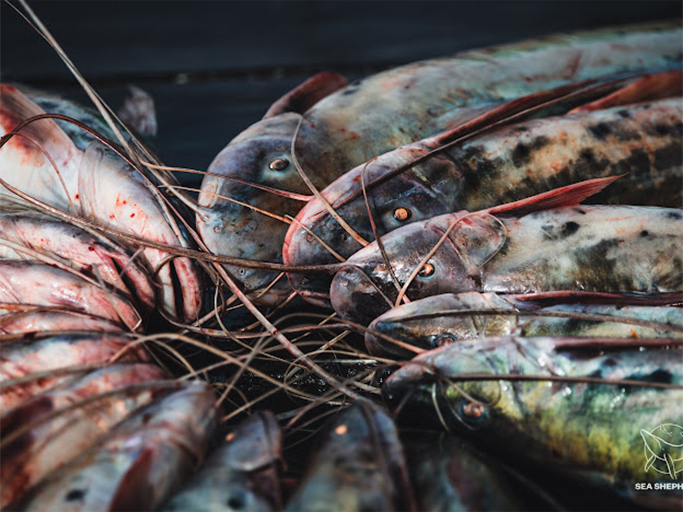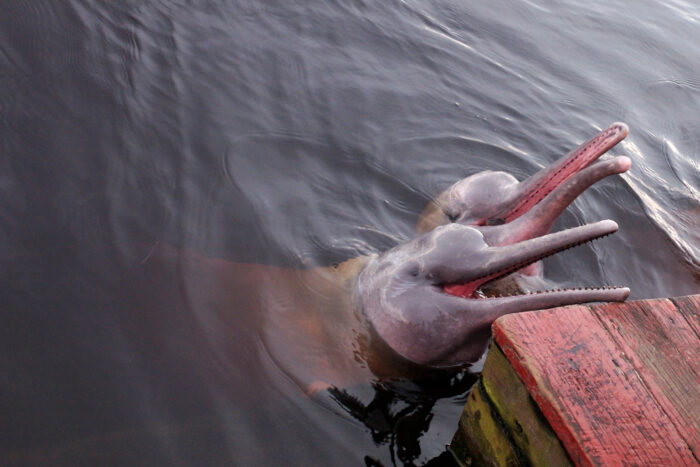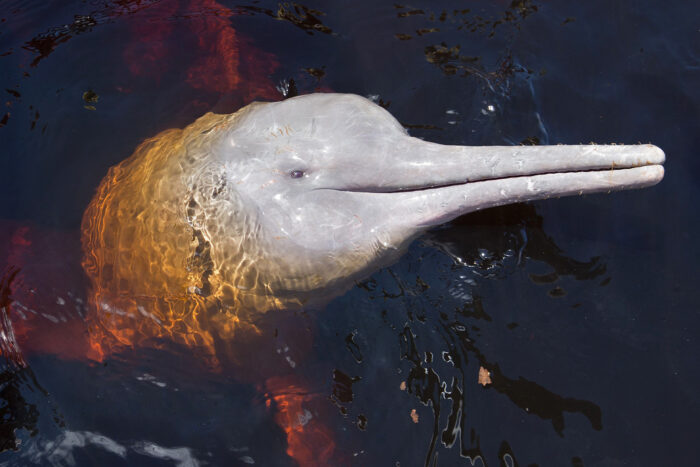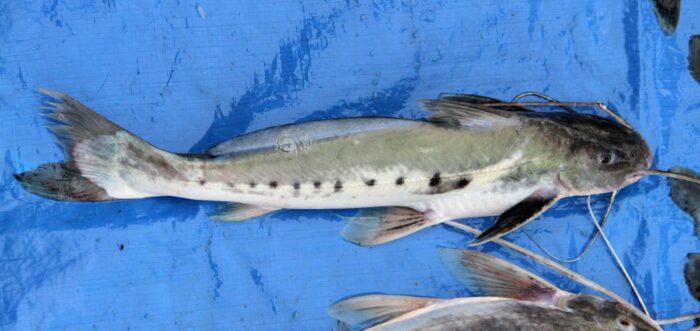- The Amazon river dolphin, or boto, is an integral feature of the rainforest’s biodiversity and culture, and is central to several Indigenous tales.
- Even though the dolphin isn’t fished for human consumption, it’s become endangered over the decades because fishers use its flesh as bait for catching piracatinga catfish.
- The Brazilian government earlier this year renewed a moratorium on fishing of piracatinga, first imposed in 2014, in the hope of saving the dolphin, but experts say fishers have just been ignoring the rule.
- The measure became even more relevant in October following the detection of more than 100 dead dolphins in an Amazon lake — experts suspect that the deaths are directly linked to the extreme drought affecting the region.
- This article was commissioned by LAB and published by Mongabay.
- Banner image: The pink river dolphin isn’t fished for human consumption, but it’s become endangered over the decades because fishers use its flesh as bait for catching piracatinga catfish. Image by Silvio Batista Piotto Junior via Wikimedia Commons (CC BY-SA 4.0).
On July 3, 2023, a moratorium on fishing the piracatinga catfish in the Brazilian Amazon was extended for the third time since its introduction in 2014. There’s now no expiry date for the ban, although the ministries of environment and fishing have a period of three years to reevaluate it.
The moratorium was instituted to protect the pink river dolphin (Inia geoffrensis), known locally as the boto. Fishers in the region catch the dolphin not to eat it, but as bait for catching piracatinga (Calophysus macropterus), which is being increasingly fished.
While the extension of the moratorium marks a victory for environmentalists, some say the continued need for the policy demonstrates that efforts to permanently protect the dolphin by securing a safe environment for it is far from complete.
In October, over a hundred dolphins were found dead in a lake in the Amazonas state, following a severe drought expected to last all summer. Experts are analyzing the bodies, but it’s believed that the rising temperatures of water bodies in the region must have played a role in the deaths. The drought has lowered river and lake levels to record levels, restricting the flow of ships and boats, the main form of transport in the region and the only means of access to health and education facilities for many communities.
For now, most agree that the moratorium is essential to protect the animals.
Nathalie Gil, president of the Brazilian branch of Sea Shepherd, a marine conservation advocacy group, says the moratorium should remain in place until conservation experts are confident the future of the dolphins is assured. “We know [piracatinga] is still being fished illegally and there’s little control,” she says. “If fishing were legalized, then there would be no control whatsoever.”
The boto, also known as the Amazon river dolphin, is a fascinating creature, says Vera Maria Ferreira da Silva, a leading expert on Brazil’s river mammals. “It’s a beautiful animal,” she says. “As soon as I arrived in the Amazon, I was captivated by it, seeing the contrast of its pink body in the brown waters of the river.”
Silva originally came to the region to study fish, but jokingly says the Amazon river dolphin cast a spell over her, changing her career path. “When you are looking for it, it sometimes appears all of a sudden, and it’s always that: ‘Oh look, it’s the boto!’ To this day it’s like that, even after 40 years working with these animals.”
The pink river dolphin has been around the Amazon for over 15 million years. It’s an integral feature of the cultures and traditions of the people of the region, as well as an intrinsic part of the environment. Its body is so in tune with the forest that it’s adapted to the Amazon River’s two rhythms: the dry season and the wet season, when the river level rises by up to 20 meters (66 feet). Compared with its marine counterparts, the river dolphin has looser vertebrae, which gives it greater flexibility, allowing it to change direction quickly, so it can swim rapidly through the flooded forest in search of prey. It can also maneuver adroitly in very shallow water, able to turn each flipper to a different side — something that marine dolphins can’t do.
The dolphin is found in the Amazon and Orinoco rivers, which connect Brazil, Colombia, Ecuador, Guyana, Peru and Venezuela. It’s currently considered endangered on the IUCN Red List, with threats coming mostly from humans: water pollution, deforestation, and the loss of its prey from overfishing. According to Silva, however, “the fishing of piracatinga is the greatest threat the Amazon river dolphin faces in its struggle to survive.”

An endangered bait
Piracatinga has never been a popular fish among consumers in Brazil, and it had no commercial value until the 1990s. The way it eats the decomposing muscles and soft tissue of dead animals has long provoked disgust in the people in the region, earning it the names “water vulture,” “meat eater” and even “people eater.”
But this changed with the overfishing of barbado catfish (Pimelodus grosskopfii) in neighboring Colombia. Barbado is quite common in traditional Colombian dishes, so when the fish nearly went extinct there, fishers looked for a substitute and found it in the piracatinga.
Originally, fishing piracatinga only provided an additional source of income during the close season, when the fishing of certain species was banned, or when other fish were in short supply and a substitute was needed. However, fishers became increasingly reliant on piracatinga, and by 2011 they were catching around 4.4 metric tons of the fish, with demand coming from both the Colombian and Brazilian markets.
The growth in demand for piracatinga had a knock-on effect on the pink river dolphin. “Fishermen tend to use the boto as bait, because the piracatinga really enjoys mammals’ meat,” says Gil from Sea Shepherd Brasil, which funds scientific studies monitoring river dolphin populations. “Since other kinds of meat, like goat, were actually consumed by people and had commercial value, they started to use wild animals as bait, mainly the pink river dolphin and the jacaré [Caiman latirostris].”
This practice had a devastating impact on the dolphin. The species only reaches sexual maturity after the age of 10, has a gestation period of 12 to 13 months, only gives birth to one calf at a time, and then spends the next three years caring for the calf. All this translates into a low birth rate for the species, so any pressure on the population is bound to take a toll. Research from 2007 and 2011 showed that using the pink river dolphin as bait contributed to an average decline of 10% a year in its population, with scientists warning that the boto could become extinct in 30 years.

Emergency action was needed. The International Whaling Commission (IWC) called on Brazil to take better measures to conserve the dolphin, and in 2014 the government declared a moratorium on piracatinga fishing to give the dolphins some breathing space — the measure went into effect in Jan. 2015. Efforts to protect the dolphin were reinforced in 2017 when Colombia banned the piracatinga trade.
All this was positive, but the problem is that there’s been little or no monitoring of piracatinga fishing, making it easy for fishers to get around the ban, Gil says. Silva points to a study from 2019 and unpublished research carried out this year that show piracatinga continues to be widely sold under other names.
Seizures of illegal piracatinga suggest fishing levels have persisted, if not increased, despite the moratorium; in early March this year, IBAMA, Brazil’s environmental protection agency, working with support from Sea Shepherd Brasil, seized 1.6 metric tons of piracatinga — a number virtually unchanged from the amount of piracatinga sold on the market during the entire year of 2007, when it was still legal.
Gil says ineffective monitoring and illegal fishing have affected the dolphin population to such an extent that the river dolphin has all but disappeared from sections of rivers where fishing is permitted. “That’s a scary fact since the boto should be in these areas. So we believe that there is a high level of illegal fishing there too. Conversely, we found that where there are river dolphins, there is biodiversity; they work as a bioindicator.”
This year, the IWC called for stricter monitoring of illegal fishing, recommending that the moratorium should remain in place for at least another five years to complete 13 years since its imposition — “to account for the dolphin’s long reproductive cycle,” Gil says.
Silva agrees on the need for a long-term ban, though not a permanent one. “I don’t think it should last forever, but I think it should be continued indefinitely, until firstly there’s evidence that the dolphin population has recovered, secondly that piracatinga fishing is regulated and monitored effectively, and thirdly that the people who see commercial value in the piracatinga provide strong evidence and guarantees that they aren’t using any wild animals as bait.”


A dolphin in popular culture
Pink river dolphins have long been celebrated in this region, featuring in numerous beautiful and haunting stories. A common theme in many of these stories is that the boto turns into an alluring man who enjoys liquor and women by moonlight but transforms back into a dolphin in the morning.
One well-known story, recorded by Brazilian anthropologist and folklorist Lúis Câmara Cascudo, tells of two strange men who turn up at a party one night, drinking and dancing until it’s almost dawn. When they notice the time, they flee. Later in the day, two pink river dolphins are found in a very shallow puddle formed by rainwater, miles away from the river and smelling strongly of alcohol. The tale has it that the men turned into dolphins while still far from the river and only had the puddle to dive into.
Another popular story is about a woman who, after being bewitched by a male dolphin, drowns herself to be near her beloved. This story was depicted in 2012 in the Festa do Sairé, a religious festival introduced by the Jesuits into the Amazon region in the 17th century, which celebrates both the boto and the tucuxi (Sotalia fluviatilis), another species of river dolphin. It takes place each year in Alter do Chão on the banks of the Amazon River.
“For us it’s history, not just tales,” says João Pedro Borari, a member of the Indigenous Borari community who represented the male dolphin in the festival from 2012 to 2016. “Our people have lived those stories about the dolphin, so for us it’s history, not a myth.”
He says there are women from his hometown who say they danced with the dolphin long ago. They say they knew it was him from the clothes he wore: white garments and a hat to hide the hole in his head, like dolphins who transform into men often do in the stories. The man, after dancing and drinking, the story goes, disappeared and was never seen again.

“The pink river dolphin is part of an ecosystem; it is part of the environment,” João Pedro says. “We, the Borari people, have a strong connection with nature, with the environment, with the place we live in, [and that’s why] the dolphin is important both to maintain our culture and to help in the preservation of the environment.”
This highlights a crucial issue: At which point does the extinction of the dolphin also risk the annihilation of a people’s culture, tradition and history?
The idea of culture as a human right that the government must uphold is enshrined in Article 215 of Brazil’s Constitution. It declares the state “will guarantee to all the exercise of cultural rights and access to sources of national culture and will support and incentivize the valorization and diffusion of cultural manifestations.”
The disappearance of the dolphin, then, threatens not just a living piece of Borari history, but also a living piece of Brazilian culture.
This same sentiment was expressed from an environmental perspective in an open letter to the environment and fishing ministries. The letter, organized by Sea Shepherd Brasil and cosigned by more than 75,000 Brazilians and various environmental groups, was delivered on June 29, along with a petition asking for the piracatinga fishing moratorium to be extended indefinitely. According to Gil, the right of all people to enjoy a healthy environment, enshrined in Article 225 of the Constitution, would be violated by the loss of the dolphin, as the degradation of any species affects directly and indirectly the quality of human life.
This issue is relevant for the cultural, historical, biological and environmental preservation of other river dolphin species across the world, all of which are today categorized as threatened on the IUCN Red List; one species, the baiji (Lipotes vexillifer), once found throughout the Yangtze River Basin in China, is believed to have gone extinct.
In Latin America, most river dolphin species can be found in the Amazonian waters of Brazil, Bolivia, Venezuela, Colombia, Ecuador and Peru. Environmentalists in these countries have long fought for the conservation of the dolphins and their habitats, as well as for more active measures to regulate the fishing of piracatinga and the killing of the boto, as a means of contributing to the protection of the South American ecosystem, tradition and culture.
17 October: this version of the article has been edited to clarify some points made by Nathalie Gil

